‘Better without the ladies’: the Royal Irish Academy and the admission of women members
Published in 18th-19th Century Social Perspectives, 18th–19th - Century History, Features, General, Issue 6 (Nov/Dec 2011), Volume 19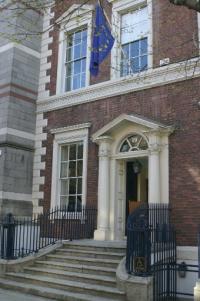
The Royal Irish Academy, Dawson Street. (RIA)
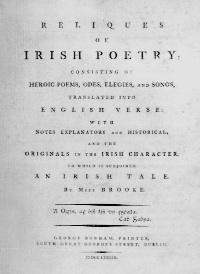
Title-page of Reliques of Irish poetry (1789) by Charlotte Brooke, the only woman active in antiquarian research at the time of the Academy’s foundation in 1785. In 1787 she petitioned unsuccessfully to be appointed housekeeper for its recently acquired premises.
Maria Edgeworth, first Irish female honorary member
In 1842 the Academy elected the first of its two Irish female honorary members.(First to be published) This was Maria Edgeworth, the best-known (male or female) Irish novelist of the day, whose father, Richard Lovell Edgeworth, had been a founder member of the Academy and one of the famous Lunar Society of Birmingham members before he moved to Ireland. The minutes of the Academy record that she was elected ‘by acclamation’, but it could be said that they had waited until almost the last minute to honour her—given that she was 74 in 1842, and with her creative years behind her. We do not know how Edgeworth viewed her belated recognition by the premier institution in Ireland charged with promoting ‘polite literature’. We have, however, some insight into her views on such male-only bodies from her writings. In her Letters for literary ladies, an early work of 1795 which advocated the proper education of women for, amongst other reasons, the improvement of family life, she argued that if men ‘meet with conversation suited to their taste at home, they will not be driven to clubs . . . from which ladies are to be excluded’.Some 40 years later, and four years before being made an honorary academician, her friend the mathematician William Rowan Hamilton, as newly elected president of the RIA, consulted her as to how best the Academy could advance ‘the interests of polite literature’ in Ireland. She used the opportunity to suggest opening the Academy to women, albeit in a limited way:
‘. . . [Y]our admitting ladies to your evening parties would be advantageous—I think provided you do commence those parties for the ladies late enough for their fashion and so give your gentlemen time enough to themselves after dinner for conversation and discussions which might be uninteresting to the fair visitors or in which they might possibly be de trop . . .’
As Edgeworth explained in a later letter, what she had in mind here was for the Academy to create in Dublin a version of the celebrated informal conversaziones or soirées held regularly in London by the science writer Jane Marcet (a close friend of Edgeworth’s), where, as she told Hamilton, she ‘had the pleasure and advantage of meeting all [Marcet’s] scientific and literary friends who used to give her half an hour [on] their way to or from the meetings of the Royal Society’, and she assured him that such events were ‘very agreeable to men of both science and literature’. Here Edgeworth was anticipating, by a decade or two, the establishment by most learned bodies of at least annual conversaziones, through which the middle-class appetite for science and the arts was catered for by evenings of public lectures, music and exhibitions in the premises of the societies.
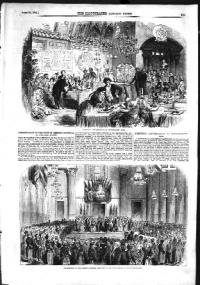
A conversazione at London’s Apothecaries’ Hall in 1855.
Edgeworth rebuffed
Hamilton, however, politely but firmly rejected Edgeworth’s suggestion, arguing firstly that it was ‘physically impossible to give accomodation [sic] to ladies’, owing to the small size of the Academy’s meeting room, and secondly that their regular meetings involved the discussion of ‘questions of legislation and finance’ and that while it was ‘comparatively easy to desire male visitors to withdraw . . . it would be hard to ask ladies to do so’. His solution was to maintain the men-only format, with the hope that their meetings would afterwards generate discussion ‘in the more graceful circle of the drawing-room, and with the advantage of that animation and polish which belongs to good female society’. Edgeworth’s response to this patronising rebuff was wonderfully ironic in its apparent feminine meekness:
‘I am rather sorry that you wasted a page upon a suggestion of mine which you have completely convinced me could not be carried into effect, and which . . . at the moment I put it on paper . . . seemed to me to be too lady-like a scheme—to smell too much of the drawing room if not of the shop—you are certainly as you have proved to me physically and morally, and intellectually better without the ladies—without turning your academical questions and business into conversazione babble . . .’
Almost twenty years later, the Academy held an elaborate conversazione during the 1857 meeting of the British Association for the Advancement of Science (BAAS) in Dublin, taking over the neighbouring public rooms and gardens of the lord mayor’s residence for the purpose.Clearly the problem of space could be overcome for the BAAS, if not for the ‘ladies’ of Dublin.
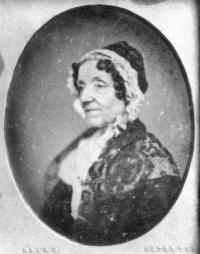
Maria Edgeworth’s suggestion twenty years earlier to create a Dublin version was rebuffed by the Academy. (Illustrated London News, 28 April 1855; National Portrait Gallery, London)
Legal obstructions
When the campaign for university education for women was finally successful (from the early 1880s the Queen’s Colleges began to admit women students, with Trinity College Dublin bringing up the rear in 1904), it was inevitable that a woman would be nominated for full membership of the RIA. The admission of women was on the agendas of many learned societies at around this time. In 1903 the Linnaean Society in London resolved the issue in favour of admitting women by obtaining a supplementary charter which inserted the words ‘without distinction of sex’ into the clauses relating to the election of fellows. But in 1902, when the Royal Society was forced to consider the nomination of the first woman fellow, the legal advice was that their charter definitely precluded married women joining and very probably single women also. Since the RIA had always modelled itself closely on the Royal Society, it was perhaps inevitable that when, in 1910, it was faced with the first nomination of a woman member (referred to only as ‘a [widow] lady’) this negative decision would be influential. At a Special Meeting of Council in February 1910 there seems to have been some support for the nomination and the principle it would have established, as a motion was introduced to accept the nomination under the usual procedures and to put it to a ballot of members. An amendment to this was passed, however, to defer the issue until legal advice was obtained. Writing the following September, the Academy’s solicitor relied heavily in his opinion on that supplied to the Royal Society in 1902, and advised that under the current charter women could not lawfully be admitted to membership.
Sex Disqualification (Removal) Act
There the matter rested until 1919, when Westminster passed the Sex Disqualification (Removal) Act, article 1 of which stated, among other things, that a ‘person shall not be disqualified by sex or marriage from . . . admission to any incorporated society (whether incorporated by royal charter or otherwise)’. A number of learned societies in the two islands were slow to react to this unambiguously enabling act, but the Irish academies had, perhaps, the excuse that the act came at a time of political and military upheaval in the country, just as the War of Independence got under way. The new Irish Free State that came into existence in 1922 gave a clear (but, as it turned out, misleading) signal of progressive tendencies in terms of women’s rights by granting the vote to all citizens ‘without distinction of sex’ at the age of 21 (30 remained the qualifying age for British women until 1928). British statute and common law up to 1920 continued to have force in Ireland, unless or until amended or repealed by the Irish government, so that the 1919 Sex Disqualification (Removal) Act remained valid.In 1927, however, as part of a backlash against women’s rights, the Irish Free State government amended the 1919 Sex Disqualification (Removal) Act in order to abolish women’s duty to undertake jury service, requiring them to opt in should they wish to serve. Given the government’s determination to reassert legally the traditional place of women in the home rather than in public life, the status of the 1919 act was felt to be in doubt throughout the 1920s, and this provides one possible explanation for the reluctance of the RIA to accept the legal position and open its membership to women. When, in 1930, the council finally sought legal opinion on the question in the light of the 1919 act, their solicitor advised that ‘the charter of the Academy must now be read as applying to women as well as men’ but that this legislation did not provide for the appointment of women as officers of the Academy.
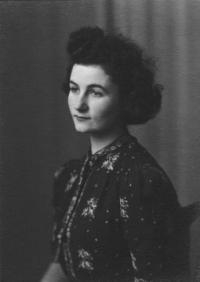
Sheila Tinney (née Power), lecturer and later Associate Professor of Mathematical Physics (Quantum Theory) at UCD.
First women members elected in 1949
So in 1931 the RIA, like the other reluctant learned societies of the two islands, had to bow to the inevitable: the president, according to the council minutes, ‘made a statement informing the council that legal opinion had been taken on the question of the eligibility of women for membership of the Academy. The opinion given was that in the existing state of the law women are eligible.’ As with the Royal Society (and many other national academies of science), however, the first female members were not elected until after World War II. In 1949 four women were admitted, two scientists and two in the humanities: Sheila Power (later Tinney), lecturer and later Associate Professor of Mathematical Physics (Quantum Theory), UCD; Phyllis Clinch, lecturer and later holder of the chair in Botany, UCD; archaeologist and art historian Françoise Henry, UCD; and Eleanor Knott, Professor of Celtic Languages, TCD. Between 1950 and 1957 seven more women were elected (one per year), three in science and four in the humanities, making a total of eleven women members. Thirty years later, in 1987, the figure still stood at eleven, out of a total membership of 250 (or just over 5%). (It was at this time that I witnessed the members’ procession containing one solitary female.) Since then there has been a concerted effort to elect more women, bringing the total, as of 2011, to 56 female members. The overall membership has increased to 455, however, so the proportion of women has only increased to 12.3%. Most are in the humanities (45 in total), reflecting, in part, the global scarcity of women in the sciences. Indeed, the gender balance is likely to continue this glacial progress towards equality as a result of a decision to concentrate recruitment in the information technology and engineering fields, which could be seen in the 2010 and 2011intakes, in which just nine out of 48 new members were female.
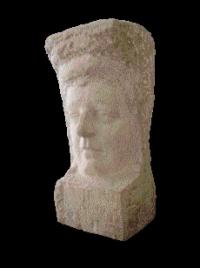
Françoise Henry (bust), archaeologist and art historian, UCD—two of the four women finally elected to RIA membership in 1949. (Hugh Tinney; NCAD)
Yet when one turns one’s attention to the sizeable administrative staff who run the extensive research and publishing programmes now under the Academy’s remit, the gender balance is reversed: it is overwhelmingly female (although with disproportionately more men in senior positions). Thus, more than 200 years after her fruitless petition, Charlotte Brooke might now readily find space in that part of the Royal Irish Academy, but this hardly seems like sufficient progress after two centuries. HI
Clare O’Halloran lectures in history at University College Cork.
Further reading:
T. Ó Raifeartaigh (ed.), The Royal Irish Academy: a bicentenary history (Dublin, 1985).


















